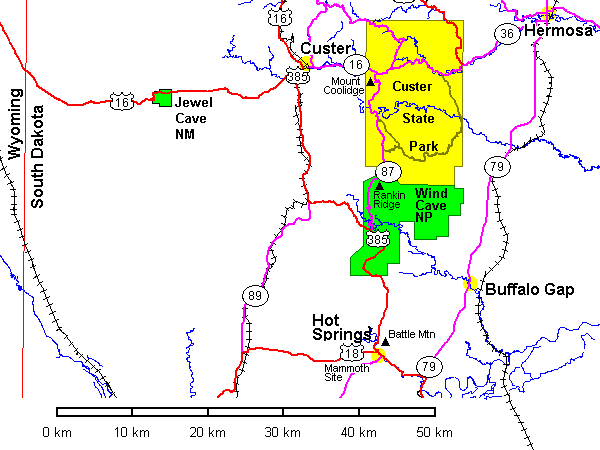Battle Mountain, South Dakota
Steven Dutch, Professor Emeritus, Natural and Applied Sciences, Universityof Wisconsin - Green Bay


 |
This historical marker tells about an epidemic that struck the local Indian tribes about the middle of the 16th century (1550 or so). The plague ended, according to the story, when a messenger brought news of a healing spring that cured the illness. Battle Mountain got its name from a 19th century clash between the Sioux and the Cheyenne over control of the springs. |
 |
The hot springs are not extremely hot and are not related to subterranean
magma. They are more likely related to deep fracture systems that allow
water to penetrate several kilometers deep. The date of the plague is only a few decades after the Spanish conquest of Mexico, about enough time for European diseases to diffuse this far. It would be another 200 years before any Europeans actually visited this area. Historians are becoming increasingly aware that European diseases devastated populations far removed from the zone of immediate contact. |
 |
Left and below: views from the summit, from southeast (left) through south, west, and northwest. |
 |
 |
 |
 |
 |
Below: the city of Hot Springs. |
 |
 |
 |
 |
 |
 |
 |
Left: Inyan Kara Group sandstones. |
 |
Left and below: The summit is underlain by silicified, iron-stained sandstones of the Jurassic Inyan Kara Group (Fall River and Lakota Formations). |
 |
 |
 |
 |
 |
|
 |
Battle Mountain with Spearfish Formation in the foreground. The soft orange Spearfish Formation eroded to form a valley surrounding the Black hillsand within an outer ring of hills formed by resistant Jurassic units. The Indians called the valley the Red Valley; Europeans sometimes called it the Racetrack. |
Panorama from Battle Mountain, from south on the left to northwest on the right. The city of Hot Springs is in the valley. A large limestone quarry in the Minnelusa Limestone is visible to the west just left of a communications tower.

Return to Historic Sites Index
Return to Virtual FieldTrips Index
Return to Professor Dutch's Home Page
Created 15 January 2005, Last Update 06 June 2020